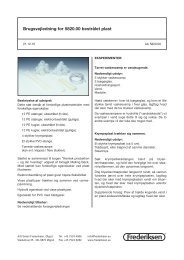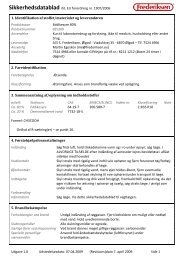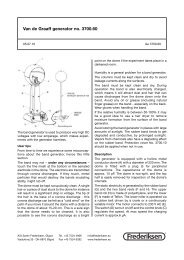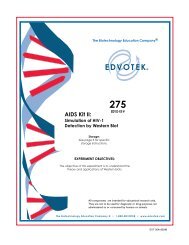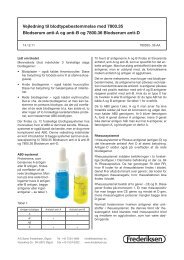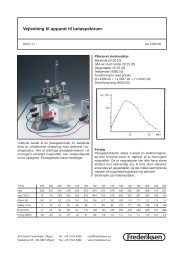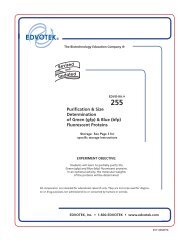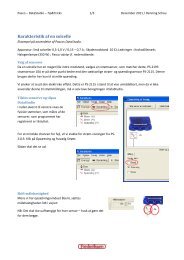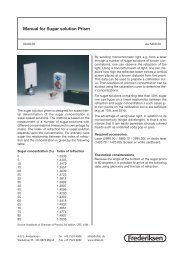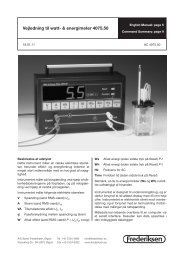Waves, sound and light - Frederiksen
Waves, sound and light - Frederiksen
Waves, sound and light - Frederiksen
- No tags were found...
Create successful ePaper yourself
Turn your PDF publications into a flip-book with our unique Google optimized e-Paper software.
waves, <strong>sound</strong> <strong>and</strong> <strong>light</strong>271821011123919171315162018145The ripple tank is shown with themirror <strong>and</strong> projection screen inplace. By removing these, thewavepattern is projected onto thetable top <strong>and</strong> can be traced on asheet of paper.67The included vibrator is ourrugged model 2185.00– see next page for details.The complete ripple tank comprises the following individualparts:1) Stroboscope unit (2211.01)2) Power Supply (Eur: 3550.50/UK: 3550.52)3) Traverse <strong>and</strong> rods (2) f. strobe (2210.62)4) Legs (3) <strong>and</strong> plate holder (2210,1013)5) Ripple Tank (2210.33)6) Mirror (2210,1011)7) Projection screen (2210,5093)8) Vibration Generator (2185.00)9) Holder for lever arm (2185.05)10) Lever Arm w. pivot (2210.32)11) Rod with cross foot (2185.06)12) Height adjust unit (2185.07)13) Cable for vibrator (1100.75)14) Remote control f. single pulses (1100.80)15) Acrylic block, convex (2210.29)16) Acrylic block, concave (2210.28)417) Acrylic block, prism (2210.30)18) Dipper for parallel waves (2210.25)19) Pipette flask w. detergent (2210,3190)20) Accessories in box (2210,0016)Comprises:Single dipper (2210.22)Double dipper (2210.23)Barriers, long (2) (2210.26)Barrier, short (2210.27)Single dipper tips (5) (2210,2202)Spare pipette (0561.15)The ripple tank set is supplied in a fibre box segmented forstoring the components <strong>and</strong> with complete user instructions.2211.00 Ripple Tank0006.00With the ripple tank you will need a retortst<strong>and</strong> base like 0006.000006.00 Retort st<strong>and</strong> basescience®
28waves, <strong>sound</strong> <strong>and</strong> <strong>light</strong>Vibrator <strong>and</strong> accessoriesElectromechanical vibratorThis vibrator generates powerful mechanical vibrations whenused with a signal generator like 2502.50. The rugged constructionmeans years of problem-free use. The unit is fuseprotected <strong>and</strong> supplied with a lock to fix the moving parts whilechanging accessories. The vibrator is supplied with mountinghardware, a string holder <strong>and</strong> a spare fuse.Max. input: 6 V/1A.Dimensions: 120 mm x Ø 100 mmWeight: 1.26 kg2185.00 Electromechanical VibratorChladni platesFor use with 2185.00. A thin layer of fine s<strong>and</strong> is spread overthe plate, <strong>and</strong> resonance patterns (”Chladni” figures) can beobserved at certain frequencies. The plate resonances areaudible.2185.20 Resonance 8833.00-3plate, square2185.25 Resonanceplate, circular2185.00Flat springs for resonance experimentsVarious lengths. For use with 2185.00. Fundamental frequenciesat 11, 15, 21, 36 <strong>and</strong> 50 Hz can be readily observed.Interesting st<strong>and</strong>ing waves can be seen up to 300 Hz <strong>and</strong>heard up to 900 Hz.2185.30 Flat Springs for resonance experiments8833.00-3S<strong>and</strong> for Chladni plates2185.302185.20Gas model with pistonFor use with the 2185.00. See page 19.2185.55 Gas model with piston2185.252185.55®science
waves, <strong>sound</strong> <strong>and</strong> <strong>light</strong>29Rubber string2 metres. For use with 2185.00 for demonstrating st<strong>and</strong>ingwaves.2185.40 Rubber stringLongitudinalwave spring155 mm long <strong>and</strong>27 mm diameter.Spring constant4,7 N/m.2155.50Spiral spring2185.402155.50Lissajous’ apparatusThis apparatus is actually a simple oscilloscope.A moveable mirror is resting on a steel ball. The mirror tiltss<strong>light</strong>ly along two perpendicular axes, controlled by two2185.00 vibrators. The mirror reflects a laser beam onto ascreen. In this way the movements of the mirror is amplified.If the two vibrators are connected to two signal generators (like2502.50), whose frequencies are adjusted to a simple ratio –like 2:3 or 4:7 – the laser ray will draw a so-called Lissajouspattern on the screen.Vibrators, signal generators <strong>and</strong> <strong>light</strong> source are not included.2185.60 Lissajous’ apparatusPiano wire ringUsed with 2185.00 fordemonstrating therelationship betweenfrequency <strong>and</strong> thenumber of vibrationalnodes.Diameter: 290 mm.2185.10Piano wire ring2185.002185.102185.60Additional Equipment Needed2 ea. Electromagnetic vibrators (2185.00)2 ea. Signal generators (e.g. 2502.50)1 ea. Laser (2885.00)2185.00science®
30waves, <strong>sound</strong> <strong>and</strong> <strong>light</strong>Function generatorDesigned for educationIn our development team we include experienced physicsteachers. This ensures that the technical perfection goes h<strong>and</strong>in h<strong>and</strong> with usefulness.For basic use, you just operate two large buttons: One forfrequency – one for amplitude. That’s it.If you want to change waveform or to utilise the new step <strong>and</strong>sweep modes, the display keeps you updated on the status ofthe generator.Unique frequency controlThe frequency is set by a speed sensitive button. Turn slowlyto set the display’s last digit. Turn faster, <strong>and</strong> the responseaccelerates softly. We have designed this function to work intuitivelyin practical experiments with common physics equipment.Drives speaker, vibrator etc. directlyThe built-in 10 W power amplifier drives effortlessly powerconsumingappliances as e.g. a vibrator. The amplifier c<strong>and</strong>eliver more than 1 A for all frequencies between 0.001 Hz<strong>and</strong> 100 kHz <strong>and</strong> is directly coupled to the generator part - noswitches or external cables complicates use.Step modeIn many applications you need to study a physical systemat a fundamental frequency <strong>and</strong> at different multiples of thisfrequency. The special step feature makes this task a breeze.Sweep modeThe generator can sweep through a frequency range in orderto discover eventual resonances. You decide the frequencyrange <strong>and</strong> the speed. You have the choice between a linearsweep (fixed number of Hz per time) <strong>and</strong> a logarithmic sweep(fixed number of octaves per time).Advanced FeaturesThe generator connects to your PC through a st<strong>and</strong>ard USBcable <strong>and</strong> acts as a USB memory stick.Custom defined waveforms (e.g. created by means of aspreadsheet) can be saved to the generator.Sequences of settings can be programmed for automaticexecution.SpecificationsBuild-in waveformsBipolar:Sine, triangle, squarePositive:Square pulse, triangle pulse, rampup, ramp downDistortion (sine): < 0.1 % up to 20 kHz;< 1 % otherwiseFrequency range50 Ω <strong>and</strong> sync outputs: 0.001 Hz to 10.00 MHzPower output:0.001 Hz to 100.0 kHzFrequency stability: Better than 0.005 %Amplitude50 Ω output, no load: 0 to 10 V (20 V p-p for bipolarwaveforms)Sync output: 5 V (TTL signal: 0 to 5 V)Power output:0 to 10 V (20 V p-p for bipolarwaveforms)Max current50 Ω output, short circuit: 200 mA (only briefly)50 Ω output, into 50 : 100 mA (unlimited)Power output:1 A (unlimited)Misc.Mains voltage:230 V; 50-60 Hz(115 V on request:Item no. 2502.51)Power consumption: 85 W (max) ; 21 W (idle)Dimensions (W x D x H): 312 x 205 x 117 mm2502.50 Function generator®science
waves, <strong>sound</strong> <strong>and</strong> <strong>light</strong>31Loudspeaker, smallThis small loudspeakerapproximates a point sourceof <strong>sound</strong>.Use two with functiongenerator 2502.50 inexperiments withinterference of <strong>sound</strong> waves.Mounted on a 10 mmdiameter rod.Power: 1W into 25ΩDimensions:165 mm x Ø 67 mm.2505.00Loudspeaker, small2505.00MicrophoneThe small size of this microphone makes it ideal for experimentswith <strong>sound</strong> interference. Other typical applications aremeasurement of <strong>sound</strong> frequencies, speed of <strong>sound</strong> experiments<strong>and</strong> the recording of <strong>sound</strong> by data loggers.It is supplied with a one metre cable with a 6 pole, 240° DINplug which connects directly to the electronic counter type2002.50 or student timer 2006.60.The microphone can be connected to an oscilloscope or othermeasuring instruments via type 2515.60 power supply.The frequency range is 20-20,000 Hz.Supplied with Ø 10 mm support rod.Dimensions: 105 mm x Ø 30 mm.2485.10 Microphone without st<strong>and</strong>2510.51Carbon microphoneThis historically importantmicrophone type has aresistance that varies when<strong>sound</strong> waves compress thecarbon granules in themicrophone capsule. Itshould be connected to anexternal DC power supplythough a series resistor.The microphone is providedwith a cable with 4 mmsafety jacks <strong>and</strong> mountedon a Ø 10 mm support rod.(St<strong>and</strong> base not included.)Resistance: 150 ΩMaximum current: 50 mA.Dimensions: Ø 67 x 155 mm.2490.00Carbon microphoneLoudspeakerThis three-way full rangespeaker system can be usedwith e.g. the type 2502.50function generator in thestudy of <strong>sound</strong>, frequency,amplitude <strong>and</strong> timbre.A Ø 10 mm steel rod makesit easy to place the loudspeakeron a st<strong>and</strong> base like0006.00 (not included).Frequency range:60 - 20.000 HzPower: 50 W into 4 ΩDimensions: H x W x D:215 x 116 x 110 mm.2510.51 Loudspeaker2490.00Microphone probe2485.10Used for measurement of <strong>sound</strong> pressure levels in locationswhich are hard to access.The probe is intended for use with 2480.10 resonance tube.Full description on page 33.2515.50 Microphone probe2515.50Power supply – battery boxMicrophones type 2485.10 are usually powered by a counteror timer. Microphone probe 2515.50 is powered when connectedto appropriate datalogging equipment.If these microphones are to be used as st<strong>and</strong>-alone units (forinstance with an oscilloscope), they need external power -which is provided by thisbattery box. Full descriptionon page 33.2515.60Power supply2515.60science®
32waves, <strong>sound</strong> <strong>and</strong> <strong>light</strong>Resonance tube for <strong>sound</strong> experimentsThis resonance tube provides many options for working with <strong>sound</strong> waves:– Examine st<strong>and</strong>ing waves in a tube open at both ends, closed at both ends or open at one end <strong>and</strong> closed at the other.– Examine st<strong>and</strong>ing waves in a closed tube containing various gasses (e.g. CO 2).– Vary the length of the half open tube by means of a piston.The apparatus consists of a Plexiglas tube with two end pieces – one with a loudspeaker <strong>and</strong> one with a hole for the piston shaftor for the 2515.50 microphone probe. Cable for the loudspeaker, piston <strong>and</strong> two mounts are included.(Microphone probe <strong>and</strong> tripod st<strong>and</strong> bases are not including).Dimensions: 100 cm x Ø 7 cm.2480.10 Resonance tubeSt<strong>and</strong>ing waves in aclosed tubeResonant states in a tubeclosed in both ends.St<strong>and</strong>ing waves in CO 2Resonant States i a tube closed inboth ends, while CO2 is fedthrough the tube.St<strong>and</strong>ing waves in a tubewith open endResonant States i a tube openin one end, <strong>and</strong> closed in the other.St<strong>and</strong>ing waves in a tubewith both ends openResonant States i a tubeopen in both ends.Resonant States i a tube openin one Changing end, <strong>and</strong> closed the length in the ofother, the while air changing column. the lengthof the tube with the movable piston.Sound A tuning come from fork either or the aspeaker or a tuningfork.loudspeaker can beused as the <strong>sound</strong>source®science
waves, <strong>sound</strong> <strong>and</strong> <strong>light</strong>332515.50Microphone probeA miniature microphone is mounted at the end of a 740 mmlong 8 mm diameter stainless steel probe for measurement of<strong>sound</strong> pressure levels in locations which are hard to access.The frequency range is 20 to 20,000 Hz.The probe is intended for use with 2480.10 resonance tube.The probe is supplied with a 2 metre cable with a DIN connector.Note: The microphone is powered by an external voltage. Thiscan be provided by our 2515.60 power supply / battery box orby data logging equipment.In order to use the microphone with a multimeter or an oscilloscopethe 2515.60 power supply is required.2515.50 Microphone probePower supply – battery boxThe power supply is designed for use with microphones <strong>and</strong>other sensors that require + 5 V DC to operate.(It also makes it possible to use certain combinations of new<strong>and</strong> old equipment like photo gates <strong>and</strong> timers – for details,refer to the manual available online.)The unit is provided with a battery compartment for 9 V alkalinebattery type 6LR61 (3510.10) which via an electronic regulatorsupplies the +5 V DC supply voltage for connected probes.The unit has two inputs with 6 pole, 240° DIN connectors <strong>and</strong>one input with an 8 pole, 270° DIN connector that also acceptsa 5 pole, 180° DIN plug.The output terminals comprise two 5 pole, 180° DIN connectors<strong>and</strong> a set of 4 mm safety connectors.Dimensions (L x W x H): 14.3 x 8.4 x 3.7 cm.2515.60 Power supply2515.602475.00Kundt’s resonance tubeThis apparatus is designed for demonstration of st<strong>and</strong>ingwaves <strong>and</strong> for determination of the wavelengths of <strong>sound</strong>waves in air. The tube is supplied with a millimetre scale <strong>and</strong>a moveable piston for changing the length of the air column.(You will also need an external <strong>sound</strong> source - e.g. 2240.10Tuning fork 1000 Hz, together with 2245.61 Striking hammer.)Dimensions: 66 cm x Ø 3 cm.2475.00 Kundt’s resonance tubeTrichordFor experiments with <strong>sound</strong> <strong>and</strong> oscillating strings. The apparatusconsists of wooden resonance box with facilities forsupporting strings under tension. One string is placed undertension using weights, while the other two can be stretchedusing a tightening key. The apparatus can be used to illustratehow the pitch of a tone depends upon the length of a string<strong>and</strong> its tension. Provided with a centimetre scale <strong>and</strong> with twosteel <strong>and</strong> one nylon string. Length: 60 cm.2465.00 Trichord2465.00science®
34waves, <strong>sound</strong> <strong>and</strong> <strong>light</strong>Tuning fork, aluminiumThe large oscillating area of these aluminium tuning forksensures a good coupling to the surrounding air, making the<strong>sound</strong> clearly audible. Use one of these in Doppler effect demonstrationsby swinging it around in a string.The lengths are 118 <strong>and</strong> 104 mm, resp. Width: 30 mm.2240.00 Tuning fork, 1700 Hz2240.10 Tuning fork, 1000 Hz2245.202240.00 2240.10Tuning forks, steelThese tuning forks are made of nickel plated steel with the tone<strong>and</strong> frequency engraved.2225.00 Tuning fork 440 Hz. Length 120 mm2230.01 Tuning fork 440 Hz. Length 145 mm2230.05 Tuning fork 256 Hz. Length 170 mm2230.10 Tuning fork 512 Hz. Length 140 mmPair of tuning forks on resonance boxesThe tuning forks are manufactured in special nickel-platedsteel. They are used for resonance <strong>and</strong> dissonance experiments.The resonance boxes are made of lacquered pine <strong>and</strong>supplied with thick felt pads on the bottom. The set includesa small weight for mounting on one arm of a fork in order tochange the frequency. The st<strong>and</strong>ard frequency is 440 Hz.Set contains: Two tuning forks + boxes <strong>and</strong> a hammer.2245.20 Pair of tuning forks on resonance boxes2235.002230.052230.102230.01Tuning fork setC-scale, physicalThe set consists of eight tuningforks from C(256) to C(512)manufactured in nickel platedsteel with frequency valuesengraved. Supplied in carryingcase.2235.00 Tuning fork set,C-scale2225.002450.00Tuning fork withwriting tipFrequency 128 Hz. One arm of the tuningfork is supplied with a pointed tip for markingthe oscillations on e.g. a soot-covered glassplate. Supplied with wooden h<strong>and</strong>le.Overall length: 335 mm.2450.00 Tuning fork with writing tip2220.00Tuning fork for demonstrationexperimentsIt is easy to hear an ordinary tuning fork but somewhat moredifficult to show how it moves. The demonstration tuning forkoscillates at a frequency which is far below the audible range(around 5.4 Hz). On the other h<strong>and</strong> it is easy to observe itsmotion. Made of nickel plated steel. Length 75 cm.2220.00 Tuning fork for demonstrationexperiments®science
waves, <strong>sound</strong> <strong>and</strong> <strong>light</strong>35Wave machineThe apparatus is used for demonstrating longitudinal <strong>and</strong>transverse waves. It is supplied with a drive shaft with a crankwhich acts on a number of vertical rods as it rotates. Each rodhas a white marking at the top. Eight of the rods are suppliedwith an angular extension which makes it possible to observethe corresponding longitudinal wave. A 360 degree scale ismounted at the crank to enable the phase angle to be determined.Dimensions: (L x H x D) 48 x 32x10 cm.2212.00 Wave machineWave apparatus for transverse wavesThis is a very illustrative piece of equipment for demonstratingtransverse wave motion. It consists of 35 massive metal rods46 cm long suspended in the middle by a metal wire. The inertiaof the system ensures slow <strong>and</strong> easily studied wave motion.The metal rods are provided with a yellow rubber marking ateach end (contrasting with the black colour of the apparatus).The apparatus provides an excellent illustration of the conceptsof wavelength, frequency, amplitude, reflection <strong>and</strong> phase.Size: 90 x 46 x 30 cm.2212.10 Wave apparatus for transverse waves2212.002212.10Spiral spring ”Slinky”This loose, large diameter spring works well on a smooth flooror a large table for demonstration of longitudinal vibrations.Length: 150 mm. Diameter: 75 mm.2155.70 Spiral spring ”Slinky”2155.702155.602155.65Spiral spring, 2 metresThe spring is used for demonstrations of transverse oscillations<strong>and</strong> for producing st<strong>and</strong>ing waves.Length, unloaded: 200 cm. Diameter: 10 mm.2155.60 Spiral spring, 2 metresSpiral spring, 3 metresThe spring is used for demonstrations of transverse oscillations<strong>and</strong> for producing st<strong>and</strong>ing waves. Large, rugged <strong>and</strong>easy to see for a large audience. This demonstration spring isideal for the introduction of the basic concepts of wave motion.Length, unloaded: 300 cm. Diameter: 19 mm.2155.65 Spiral spring, 3 metresscience®
36waves, <strong>sound</strong> <strong>and</strong> <strong>light</strong>Interference experimentsHe-Ne laserThe laser emits <strong>light</strong> with a wavelength of 632.8 nanometres.The emitted <strong>light</strong> is coherent, i.e. wave fronts propagate in thesame phase over a large distance compared with ordinary <strong>light</strong>sources. The emitted <strong>light</strong> is highly directional <strong>and</strong> the beamdiameter at the laser is about 0.5 mm increasing very graduallyat increasing distances from the laser. The <strong>light</strong> emitted is notuniformly polarized but changes its polarization at r<strong>and</strong>omaround the direction of propagation. Light from the laser isideal for demonstrations of optical interference. If a line gratingis placed in the laser beam, the interference pattern will beclearly visible on a projection screen. The laser can be usedfor a wide range of applications in optics, communication etc.2885.00 He-Ne Laser, max. 1 mW2885.10 He-Ne Laser, max. 2 mW2885.202885.00He-Ne laser, modulatedLike 2885.00 but with the option of amplitude modulating the<strong>light</strong>. The laser is provided with a BNC connector for connectionto a function generator, CD-player or similar signal source.For demonstration of optical communication the photodetector4895.50 is a perfect match.Maximum modulation frequency: 1 MHz2885.20 He-Ne laser, modulated, max. 1 mW4895.50PhotodetectorThe photodetector is provided with a photo diode whichgenerates an electrical signal proportional with the <strong>light</strong> intensity.The signal can be applied to the built in loudspeaker or usedfor measurements via the AC <strong>and</strong> DC output connections. Thephotodetector can be used for demonstrating communicationover a laser beam, fibre optic communication, plotting of interferencepatterns, etc. The maximum frequency is 1 MHz.The DC signal, proportional to the <strong>light</strong> intensity, can be monitoredby a voltmeter or datalogging equipment.4895.50 Photodetector1100.75Cable for photodetectorUsed to connect the DC output of 4895.50 to e.g. a voltmeter.1100.75 Cable, mini-jack to 2 banana plugsLaser objectiveNeeded when the laser beam is just too narrow. Together withe.g. an F = 100 mm lens this convex lens is useful for illuminationof a larger area of a diffraction grating or a slide with slits.The objective is supplied with a threaded adapter for mountingon the laser’s optics adapter.0768.86 Objective 10x achromatic, N.A. 0.250768.86®science
waves, <strong>sound</strong> <strong>and</strong> <strong>light</strong>37Laser diffraction kitThis kit comprises 18 slides which allow performance <strong>and</strong> demonstrationof e.g. Fraunhofer Diffraction, Fresnel Diffraction,a number of other diffraction experiments.– Six slides with 1 to 6 slits. Width 0.06 mm,distance 0.20 mm– Slide with holes, Diameters 0.3 – 0.4 – 0.6 – 1.0 mm– Three slides with coarse gratings– Two slides with fine diffraction gratings(80 <strong>and</strong> 300 lines per millimetre)– Slide with a fine metal gauze (300 mesh)– Slide with a tapered single slit– Slide with a tapered double slit– Two slides with polarizing filters– Slide with a transmission hologramThe slides are labelled <strong>and</strong> come in a storage box completewith an inventory list <strong>and</strong> brief experiment notes.3272.00 Laser Diffraction kit3272.00You will find more lasers <strong>and</strong> accessories in the “Optics” chapter.Interference pattern model for overheadprojectorThe set consists of two transparent plastic plates with printedwave front patterns for point sources on each plate.If the plates are placed on top of one another <strong>and</strong> s<strong>light</strong>lydisplaced, an interference pattern will appear.The pattern can readily be projected onto a large viewingscreen using an overhead projector.By varying the distance between the centres of the circles,the pattern changes <strong>and</strong> topics like diffraction orders can bediscussed.3235.00 Interference pattern set3235.00Wavelength of <strong>light</strong>The apparatus is designed to measure the wavelength of <strong>light</strong>by studying the interference pattern from a double slit. Theequipment is well suited for student lab exercises. The devicecontains a 12 V festoon lamp with a holder for colour filters <strong>and</strong>a millimetre scale with moveable markers.The <strong>light</strong> is viewed at a distance of about 3 metres through adouble slit. The viewer directs a co-worker to adjust the markersso that the distance between them corresponds to 10interference maxima. Afterwards the precise distances can bemeasured <strong>and</strong> the wavelength of the <strong>light</strong> can be calculated.Red <strong>and</strong> blue colour filters <strong>and</strong> a double slit are provided.Power source required: 12 V AC/DC, 1.3 A.3240.00 Determining wavelength3240.00science®
38waves, <strong>sound</strong> <strong>and</strong> <strong>light</strong>Sound level meter, digitalRobust, user friendly <strong>sound</strong> level meter with 4-digital display.Measuring range from 30 to 130 dB divided into three ranges.User can choose dBA or dBC weghting.The instrument is provided with a max/min feature <strong>and</strong> anAC/DC output for connection to a chart recorder or datacollection unit. An external 9V DC power supply may be used.Supplied in case with manual, battery <strong>and</strong> wind shield.Technical Specifications:Ranges: 30-80 dB, 50-100 dB <strong>and</strong> 80-130 dBAccuracy: +/- 1.5 dBResolution: 0.1 dBFrequency range: 31.5 Hz - 8 kHzDC output: 10 mV/dB, impedance: 50 ΩAC output: 1 V RMS at full scale, impedance: 600 Ω ΩPower supply: 9 V block battery or line adapterSize:275 x 64 x 30 mm2528.30 <strong>sound</strong> level meter, digital2528.302528.20Sound level meterSimple <strong>sound</strong> level meter with st<strong>and</strong>ard meter display with twoscales (high or low <strong>sound</strong> levels). The built-in microphone hasthe same response as the average human ear. With built-inreference <strong>sound</strong> for calibration check. Battery level checkfunction. Supplied in case with 9V battery <strong>and</strong> manual with<strong>sound</strong> level table.Low range: 40 - 80 dBA SPLHigh range: 80 - 120 dBA SPLDimensions: 60 x 65 x 38 mm.2528.20 Sound level meter®science



